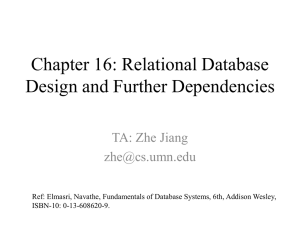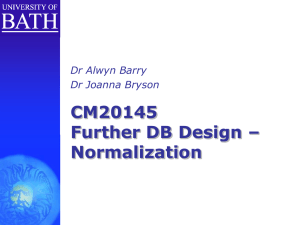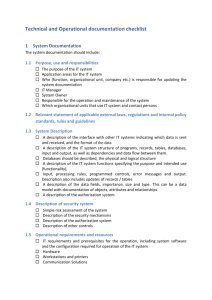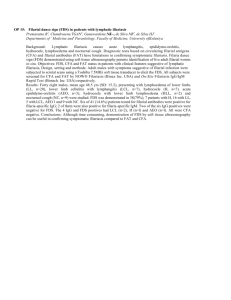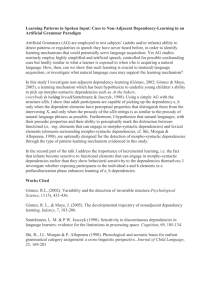6.6.3 Test for Lossless Joins – General Case
advertisement
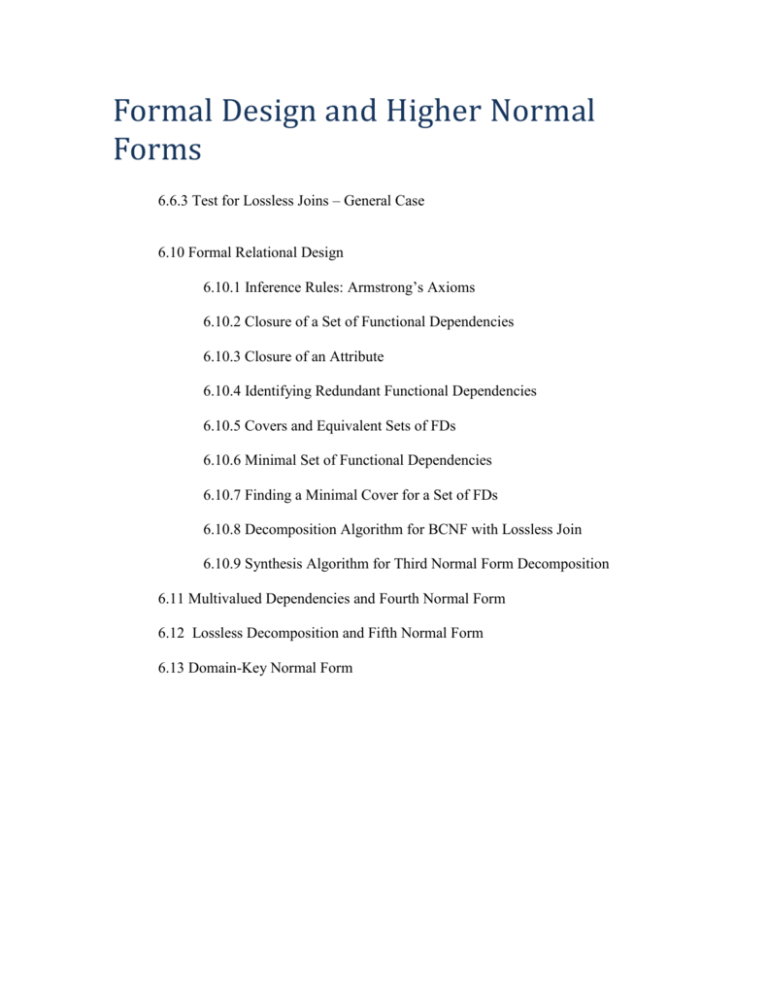
Formal Design and Higher Normal
Forms
6.6.3 Test for Lossless Joins – General Case
6.10 Formal Relational Design
6.10.1 Inference Rules: Armstrong’s Axioms
6.10.2 Closure of a Set of Functional Dependencies
6.10.3 Closure of an Attribute
6.10.4 Identifying Redundant Functional Dependencies
6.10.5 Covers and Equivalent Sets of FDs
6.10.6 Minimal Set of Functional Dependencies
6.10.7 Finding a Minimal Cover for a Set of FDs
6.10.8 Decomposition Algorithm for BCNF with Lossless Join
6.10.9 Synthesis Algorithm for Third Normal Form Decomposition
6.11 Multivalued Dependencies and Fourth Normal Form
6.12 Lossless Decomposition and Fifth Normal Form
6.13 Domain-Key Normal Form
6.6.3 Test for Lossless Joins – General Case
For a decomposition involving more than two relations, the simple test cannot be used, so
we present an algorithm for testing the general case.
Given a relation R(A1,A2,...An), a set of functional dependencies, F, and a
decomposition of R into relations R1,R2,...Rm, the following algorithm can be used to
determine whether the decomposition has a lossless join. The algorithm is illustrated in
Figure 6.9 below.
Algorithm to test for lossless join:
1. Construct an m by n table, S, with a column for each of the n attributes in R and a row
for each of the m relations in the decomposition.
2. For each cell S(i,j) of S,
if the attribute for the column, Aj, is in the relation for the row, Ri,
then place the symbol a(j) in the cell
else place the symbol b(i,j) there
3. Repeat the following process until no more changes can be made to S:
for each FD X → Y in F
for all rows in S that have the same symbols in the columns corresponding
to the attributes of X, make the symbols for the columns that represent attributes of Y
equal by the following rule:
if any row has an a value, a(j), then set the value of that column in
all the other rows equal to a(j)
if no row has an a value, then pick any one of the b values, say
b(i,j), and set all the other rows equal to b(i,j)
4. if, after all possible changes have been made to S, a row is made up entirely of a
symbols, a(1), a(2), ... , a(n), then the join is lossless. If there is no such row, the join is
lossy.
Example:
Consider the relation R(A,B,C,D,E) having decomposition consisting of R1(A,C),
R2(A,B,D), and R3(D,E) with FDs A → C, AB → D, and D → E. Figure 6.9 illustrates
the algorithm. Referring to Figure 6.9(a), we construct one row for each relation in the
decomposition and one column for each of the five attributes of R. For each row, we
place the value a with the column subscript in any column whose heading represents an
attribute in that relation, and the value b with the usual row and column subscript in the
column for any attribute not in that relation. For example, in the first row, for relation
R1(A,C), we place a(1) in the first column, for A, and a(3) in the third column, for C.
Since B does not appear in R1, we place b(1,2) in its column. Similarly, we place b(1,4)
in the D column and b(1,5) in the E column, since these attributes do not appear in R1.
Now we consider the FD A → C, and look for rows that agree on the value of the
lefthand side, A. We find that rows 1 and 2 agree on the value a(1). Therefore, we can set
the C values equal. We find that row 1 has an a value, a(3), in the C column, so we set the
C column value of row 2 equal to a(3). Considering the second FD, AB → D, we cannot
find any two rows that agree on both their A and B values, so we are unable to make any
changes. Now considering the FD D → E, we find that row 2 and row 3 agree on their D
values, a(4), so we can set their E values equal. Since row 3 has an E value of a(5), we
change the E value of row 2 to a(5) as well. Now we find that the second row has all a
values, and we conclude that the projection has the lossless join property
R(A,B,C,D,E)
Decomposition: R1(A,C), R2(A,B,D), R3(D,E)
FD's: A → C, AB → D, D → E
| A
B
C
D
E
__________________________________________________________________
R1(A,C)
| a(1)
|
R2(A,B,D) | a(1)
|
R3(D,E)
| b(3,1)
b(1,2)
a(3)
b(1,4)
b(1,5)
a(2)
b(2,3)
a(4)
b(2,5)
b(3,2)
b(3,3)
a(4)
a(5)
Figure 6.9(a) Initial placement of values
| A
B
C
D
E
__________________________________________________________________
R1(A,C)
| a(1)
|
R2(A,B,D) | a(1)
|
R3(D,E)
| b(3,1)
b(1,2)
a(3)
b(1,4)
b(1,5)
a(2)
a(3)
a(4)
a(5)
b(3,2)
b(3,3)
a(4)
a(5)
Figure 6.9(b) Table after considering all FDs
Figure 6.9 Testing for Lossless Join
6.10 Formal Relational Design
6.10.1 Inference Rules: Armstrong’s Axioms
To begin the more formal approach to normalization, we need a set of axioms that
provide rules for working with functional dependencies. Rules of inference for functional
dependencies, called inference axioms or Armstrong's Axioms, after their developer,
can be used to find all the FDs logically implied by a set of FDs. These rules are sound,
meaning they are an immediate consequence of the definition of functional dependency
and that any functional dependency that can be derived from a given set of FDs using
them is true. They are also complete, meaning they can be used to derive every valid
inference about dependencies, so that if a particular FD cannot be derived from a given
set of FDs using these rules, then the given set of FDs does not imply that particular FD.
Let A, B, C, and D be subsets of attributes of a relation R. The following axioms hold
(Note that AC means the union of set A and set C here):
Reflexivity. If B is a subset of A, then A → B. This also implies that A → A
always holds. Functional dependencies of this type are called trivial functional
dependencies.
Augmentation. If A → B, then AC → BC.
Transitivity. If A → B and B → C, then A → C
The following rules can be derived from the previous three:
Additivity or Union. If A → B and A → C, then A → BC
Projectivity or Decomposition. If A → BC, then A → B and A → C
Pseudotransitivity. If A → B and CB → D, then AC → D.
These rules can be used to develop a formal theory of functional dependencies, but
we will concentrate instead on their practical applications.
6.10.2 Closure of a Set of Functional Dependencies
For normalization, it is necessary to identify superkeys, candidate keys, and other
determinants, which we can do if we have identified all the functional dependencies in a
relation. We also need to be able to reason about all the functional dependencies implied
by a given set of functional dependencies. Doing so requires the notion of the closure of
a set of FDs. If F is a set of functional dependencies for a relation R, then the set of all
functional dependencies that can be derived from F, F+, is called the closure of F.
Armstrong's axioms are sufficient to compute all of F+, that is, if we were to apply these
rules repeatedly, we would find all the functional dependencies in F+. However, the task
would obviously be very complex and take a lot of time. It would simplify matters if we
could find a smaller set of FDs that we could use instead of all of F+.
6.10.3 Closure of an Attribute
Given a set of functional dependencies F of a relation R, we are often interested in
finding all the attributes in R that are functionally dependent on a certain attribute or set
of attributes, A, in R. We call this set of attributes the closure of A or A+. Clearly, if A+ is
all of R, then A is a superkey for R. We could find A+ by computing all of F+ and then
choosing only those functional dependencies where A is the determinant, but there is a
shortcut. The following algorithm can be used to find A+, given a set F of functional
dependencies:
Closure algorithm for attribute set A:
result ← A;
while (result changes) do
for each functional dependency B → C in F
if B is contained in result then result ← result C;
end;
A+ ← result;
For example, let R be a relation with attributes W,X,Y,Z and functional
dependencies
W→Z
{Y,Z} → X
{W,Z} → Y
Let us compute {WZ}+. We assign {WZ} to result and enter the while
for the first time. We look for an FD whose determinant is contained in result, which
has only WZ at the moment. The FD {W,Z} → Y, satisfies this requirement, so we
assign {WZ} Y to result. Since we had a change in result, we enter the
while again. Now we look for an FD where W, Z, Y or any combination of these three
is a determinant. We can use {Y,Z} → X, and now we assign {{WZ}Y)} X to
result. Since we have found that every attribute of R is in {WZ}+, WZ is a
superkey.
To find W+, we assign W to result and enter the while for the first time. The
FD W → Z has W as a determinant, so we assign W Z to result. Since we had a
change to result, we enter the while again. This time we use {W,Z} → Y, so we
assign {WZ} Y to result. Now we look for an FD where any combination of
attributes W,Z,Y appears as the determinant. This time we can use {Y,Z} → X, and now
we assign {{WZ}Y} X to result. Since we have found that every attribute of R
is in W+, W is a superkey for this relation. Because it has no proper subset which is also a
superkey, W is a candidate key as well. Note that we now know that WZ is not a
candidate key.
It is easy to verify that {YZ} is not a superkey. We start with
result←{YZ}. Using {Y,Z} → X, result becomes {YZ] X. Now we look for
an FD where some combination of Y,Z,X is the determinant. Since there is none, we
cannot add any new attributes to result. This means that {YZ}+ is only
{{YZ}X}, so W is not functionally dependent on {YZ}, which means {YZ} is
not a superkey.
The closure algorithm also allows us to determine whether a particular functional
dependency exists in R. For attribute sets A and B, if we wish to determine whether A→
B, we can calculate A+, and see if it includes B.
6.10.4 Identifying Redundant Functional Dependencies
Given a set of functional dependencies, we would like to be able to replace them by a
smaller but equivalent set of FDs. One way to do so is to determine whether any of them
is redundant, meaning that it can be derived from the others. To do so, we can use the
following algorithm:
Algorithm for determining redundancy in a set of of FDs
1. Choose a candidate FD, say X → Y, and remove it from the set of FDs.
2. result ← X;
while (result changes and Y is not contained in result) do
for each FD, A → B, remaining in the reduced set of FDs
if A is a subset of result, then result ← result B
end
3. if Y is a subset of result, then the FD X → Y is redundant.
We could then remove the FD X → Y from the set, since it can be derived from
the other FDs. By testing every FD in the set in turn and removing any that can be
derived from the others, then repeating this process with the remaining FDs we can find a
nonredundant set of FDs equivalent to the original set.
For example, suppose we have the following set of FDs:
(1) W → Z
(2) W → Y
(3) {Y,Z} → X
(4) {W,Z} → Y
We begin by testing (1), W → Z. We assign W to result. Now we search for an
FD (other than (1)) in which W is the determinant. We find one in (2), W → Y. Now we
assign W Y to result. Searching for an FD having a determinant which is contained
in WY, we find none. Therefore we are unable to show that Z is contained in result,
and we conclude that (1) is not redundant.
Next we test (2), W → Y. We assign W to result. Searching for an FD other
than (2) whose determinant is W, we find one in (1), so we can assign WZ to result.
Now we seek an FD whose determinant is contained in WZ. We find (4), {W,Z} → Y,
and now we can assign {WZ}Y to result. Since Y is now contained in result,
we can exit the while and conclude that (2) is redundant. We now eliminate (2) from
the set of FDs.
Testing (3), we assign YZ to result. We look for an FD other than (3) or (2)
(which we eliminated in the previous step) whose determinant is contained in YZ.
Finding none, we conclude that (3) is not redundant.
Testing (4), we assign WZ to result. In (1), we see that the determinant, W,
is contained in result, so we could add the right side of (1), Z, to result, but it is
already there. There is no other FD whose determinant is contained in WZ, except for
(2), which we have eliminated. Therefore we conclude that (4) is not redundant in the
reduced set of FDs since we are unable to get Y in result. Our final set of FDs is
(1) W → Z
(3) {Y,Z} → X
(4) {W,Z} → Y
6.10.5 Covers and Equivalent Sets of FDs
If F and G are two sets of FDs for some relation R, then F is a cover for G if every FD in
G is also in F+. This means that every FD in G can be derived from the FDs in F, or that
G+ is a subset of F+. To prove that F is a cover for G, we examine each FD X→Y in G.
We then calculate X+ in F and demonstrate that X+ contains the attributes of Y. If this
holds true for all the FDs in G, then F is a cover for G. For a relation R, two sets of FDs,
F and G, are said to be equivalent if and only if F is a cover for G and G is also a cover
for F, (i.e. F+ = G+). To prove equivalence, we prove F and G are covers for each other.
If G is a set of FDs in R, and G is large, we would like to be able to find a smaller
set of FDs such that all the FDs in G are also implied by that smaller set, i.e. that the
smaller set is a cover for G.
6.10.6 Minimal Set of Functional Dependencies
A set of FDs, F, is said to be minimal if it satisfies these conditions
the right side of every FD in F has a single attribute. This form is called standard
or canonical form for FDs.
no attribute on the left side of any FD in F is extraneous. This means that if X →
Y is an FD in F then there is no proper subset S of X such that S → Y can be used
in place of X → Y and the resulting set is equivalent to F.
F has no redundant FDs.
6.10.7 Finding a Minimal Cover for a Set of FDs
A cover, F, for G, is said to be a minimal cover (also called a nonredundant cover) if F
is a cover for G but no proper subset of F is a cover for G. A set of FDs may have several
minimal covers, but we can always find one of them. To do so, we begin with the set of
FDs, G. We express each FD in G in canonical form, i.e. with one attribute on the right
side. Then we examine the left side of each FD, checking each attribute on the left side
to see if deleting it does not effect G+. If the deletion of A has no effect, we delete it from
the left side. This eliminates extraneous attributes from all the FDs. Next we examine
each remaining FD and check to see if it is redundant, i.e. if deleting it has no effect on
G+. If it is redundant, we eliminate it. The final set of FDs, which we will call F, is
irreducible and equivalent to the original set. The algorithm follows.
Algorithm for finding a minimal cover, F, for a given set of FDs, G:
1. Set F ← G;
2. For each FD in F that is not in canonical form, i.e. not of the form X→{Y1, Y2,
…Yn}, replace it by the n FDs X→Y1, X→Y2,…X→Yn;
3. For each FD X→Y in F
for each attribute A that is an element of X
if ((F-{X→Y}) {(X – {A})→ Y} is equivalent to F
then replace X → Y with {X – {B}) → Y in F;
4. For each remaining FD X→Y in F
If (F-{X→Y}) is equivalent to F
Then remove X→Y from F
6.10.8 Decomposition Algorithm for Boyce-Codd Normal Form
with Lossless Join
It is always possible to find a decomposition of a relation that is Boyce-Codd Normal
Form and that has the lossless join property. The process involves finding each violation
of BCNF and removing it by decomposing the relation containing it into two relations.
The process is repeated until all such violations are removed. The algorithm is
Given a universal relation R and a set of functional dependencies on the attributes of R:
1. D ←R;
2. while there is some relation schema S in D that is not already BCNF
{
a. Find a functional dependency X→Y in S that violates BCNF
b. Replace S by two relation schemas (S-Y) and (X,Y)
}
6.10.9 Synthesis Algorithm for Third Normal Form
Decomposition
We can always find a third normal form decomposition of a relation that is lossless and
that preserves dependencies. The algorithm for the third normal form decomposition is
Given a universal relation R and a set of functional dependencies, G, on R,
1. Find a minimal cover F for G, using the algorithm given in Section 6.6.5.
2. Examine the left hand sides of all the functional dependencies. if there is more
than one functional dependency in F with the same left hand side; for example,
there is some attribute or set of attributes X, and one or more attributes Ai such
that
X→A1, X→A2,…, X→An
then combine X with the attributes on the right-hand side to form a relation
having the schema R1(X,A1,A2,…An) in which X is the key
Repeat this for all such determinants in F.
3. if none of the resulting relation schemas contains a key for the universal relation,
R, then create a new relation containing attributes that form a key for R.
6.11 Multivalued Dependencies and Fourth Normal Form
Although Boyce-Codd Normal Form is sufficient to remove any anomalies due to
functional dependencies, further research by Fagin led to the identification of another
type of dependency that can cause similar design problems. These are multivalued
dependencies. To illustrate the concept of multivalued dependencies, consider the
following relation:
JointAppoint(facId, dept, committee)
JointAppoint
facId dept
committee
F101
CSC
Math
Budget
Curriculum
F221
Biology
Library
F330
English
Budget
Admissions
Figure 6.10(a) JointAppoint table not in 1NF
JointAppoint1
facId dept
committee
F101
F101
F101
F101
F221
F330
F330
Budget
Budget
Curriculum
Curriculum
Library
Budget
Admissions
CSC
Math
CSC
Math
Biology
English
English
Figure 6.10(b) JointAppoint1 Table in 1NF showing multivalued dependencies
Appoint1
facId dept
F101 CSC
F101 Math
F221 Biology
F330 English
Appoint2
facid committee
F101 Budget
F101 Curriculum
F221 Library
F330 Admissions
F330 Budget
Figure 6.10(c) Appoint1 and Appoint2 tables in 4NF
Here we will assume that a faculty member can belong to more than one department. For
example, a professor can be hired jointly by the CSC and Math departments. A faculty
member can belong to several college-wide committees, each identified by the committee
name. There is no relationship between department and committee. Figure 6.10(a) shows
an unnormalized version of this relation. In order to make the relation 1NF, we must
rewrite it so that each cell has only one value. Although the preferred method is to create
a separate relation for each multi-valued attribute, a second method of creating 1NF is by
“flattening” the table as shown in Figure 6.10(b). Notice that we are forced to write all
the combinations of dept values with committee values for each faculty member, or
else it would appear that there is some relationship between dept and committee.
For example, without the second row, it would appear that F101 is on the Budget
committee only as a member of the CSC department, but not as a member of the Math
department. Also note that the key of the relation is now facId,dept,committee.
The resulting relation is BCNF, since the only determinant is the key. Although we have
taken care of all functional dependencies, there are still update, insertion, and deletion
anomalies. If we want to update a committee that F101 belongs to from Budget to
Advancement, we need to make two changes. If we want to insert the record of a faculty
member who is not on any committee we are unable to do so, since committee is part
of the key, so null values are not permitted in that column. This is an insertion anomaly.
Similarly, if F221 drops membership on the Library committee, we lose all the rest of the
information stored for him or her, since we are not permitted to have a null value for an
attribute of the key. Earlier, we found similar problems were caused by functional
dependencies, but there are none in this example, so we need to identify a new cause.
Although a faculty member is not associated with only one department, he or she is
certainly associated with a particular set of departments. Similarly, a faculty member is
associated with a specific set of committees at any given time. The set of departments for
a particular facId is independent of the set of committees for that faculty member. This
independence is the cause of the problems. To see how we can correct them, we need
another definition.
Definition: Let R be a relation having attributes or sets of attributes A, B, and C. There is
a multivalued dependency of attribute B on attribute A if and only if the set of B values
associated with a given A value is independent of the C values.
We write this as A →> B and read it as A multidetermines B. If R has at least three
attributes, A, B, and C then in R(A,B,C), if A →> B, then A →> C as well.
Unlike rules for functional dependencies, which made certain tuples illegal in relations,
multivalued dependencies make certain tuples essential in a relation. In the normalized
Appoint1 table shown in Figure 6.11(b), we were forced to write certain tuples because
we had included others. For example, when we wrote the combination of F101 with both
the CSC and Math department values, we had to write two tuples for each of the
committee values, Budget and Curriculum, and place each department value in a tuple
with each committee value. An exact definition of multivalued dependency describes the
tuples that must appear.
Alternate definition of Multivalued Dependency
More generally, if R is a relation with multivalued dependency
A →> B
then in any table for R, if two tuples, t1 and t2, have the same A value, then there must
exist two other tuples t3 and t4 obeying these rules
1. t3 and t4 have the same A value as t1 and t2
2. t3 has the same B value as t1
3. t4 has the same B value as t2
4. if R - B represents the attributes of R that are not in B, then the t2 and t3 have the same
values for R - B and
5. t1 and t4 have the same values for R - B
The dependency A -» B is called a trivial multivalued dependency if B is a subset of A
or A B is all of R. Now we are ready to consider fourth normal form.
Definition: A relation is in fourth normal form (4NF) if and only if it is in BoyceCodd
normal form and there are no nontrivial multivalued dependencies.
Our Appoint relation shown in Figure 6.10(b) is not in fourth normal form because of
the two nontrivial multivalued dependencies
facId →> dept
facId →> committee
When a relation is BCNF but not 4NF, we can transform it into an equivalent set of 4NF
relations by projection. We form two separate relations, placing in each the attribute that
multidetermines the others, along with one of the multidetermined attributes.
For our Faculty relation, we form the two projections
Appoint1 (facId, dept)
Appoint2 (facId, committee)
Both of these relations are in 4NF. They are shown in Figure 6.10(c).
6.12 Lossless Decomposition and Fifth Normal Form
As discussed in Section 6.6.3, not all decompositions are lossless, because there are
projections whose join does not give us back the original relation. We used as an example
of a lossy projection the relation EmpRoleProj(empName, role, projName)
shown again in Figure 6.11(a). The table shows which employees play which roles for
which projects. We can decompose the table by projection into the two tables, Table a
and Table b, shown in Figure 6.11(b). (For the moment, we ignore Table c.)
However, when we join those two tables, in Figure 6.11(c), we get an extra spurious tuple
that did not appear in the original table, thereby losing information. The original table can
be recreated only by joining the result with Table c, as shown in Figure 6.11(d). The
recreation depends on this join – that is, the final join is needed to get back the table.
EmpRoleProj
EmpName
Smith
Smith
Smith
Jones
role
designer
programmer
designer
designer
projName
Nile
Amazon
Amazon
Amazon
Figure 5.12(a) Original table EmpRoleProj
Table a
EmpName
Smith
Smith
Jones
role
designer
programmer
designer
Table b
role
designer
programmer
designer
projName
Nile
Amazon
Amazon
Table c
EmpName
Smith
Smith
Jones
projName
Nile
Amazon
Amazon
Figure 6.11(b) Projections of EmpRoleProj
EmpName
Smith
Smith
Smith
Jones
Jones
role
designer
designer
programmer
designer
designer
projName
Nile
Amazon
Amazon
Nile
spurious tuple
Amazon
Figure 6.11(c) First join using Table a and Table b
EmpName
Smith
Smith
Smith
Jones
role
designer
designer
programmer
designer
projName
Nile
Amazon
Amazon
Amazon
Figure 6.11(d) Join of first join with Table c over EmpName, projName
Figure 6.11 Example of Join dependency
A join dependency exists when for a relation R with subsets of its attributes A, B, …, Z,
R is equal to the join of its projections on A, B, … , Z.
Definition: A relation is in fifth normal form if every join dependency is implied by the
candidate keys.
Essentially, this means that the only valid decompositions are those involving candidate
keys. Join dependencies are related to multivalued dependencies, but they can be very
difficult to identify, because they are subtle. If a design consists of relations that are all
5NF, they are in their simplest useful form so there is nothing to be gained by
decomposing them further, since that would result in a loss of information.
Unfortunately, there is no simple test for 5NF. Join dependencies are believed to be
relatively rare, so designers often stop the normalization process at 4NF, BCNF, or 3NF
(to preserve functional dependencies).
6.13 Domain-Key Normal Form
The final normal form to be defined by Fagin involves the concepts of domain, key and
constraint. Fagin demonstrated that a relation in this form cannot have update, insertion,
or deletion anomalies. Therefore, this form represents the ultimate normal form with
respect to these defects.
Definition:A relation is in Domain-Key Normal Form (DKNF) is every constraint is a
logical consequence of domain constraints or key constraints.
The definition uses the terms domain, key and constraint. As usual, the domain of an
attribute is the set of allowable values for that attribute. Fagin uses the word key to mean
what we have described as a superkey, a unique identifer for each entity. Constraint is a
general term meaning a rule or restriction that can be verified by examining static states
of the database. For a constraint to exist, then, we must be able to state it as a logical
predicate and we must be able to determine whether that predicate is true or false by
examining instances of the relation. Although functional dependencies, multivalued
dependencies, and join dependencies are constraints, there are other types, called general
constraints, as well. We may have rules about relationships between attributes of a
relation (intrarelation constraints) that are not expressed as dependencies, or there may be
rules about relationships between relations (interrelation constraints). For example,
consider the
relation Student (stuId,...,credits). Suppose we have a rule that the stuId has a
prefix that changes as the student progresses; for example, all freshman have a 1, all
sophomores
a 2 ,etc. at the beginning of their ID's. This could be expressed as the general constraint
If the first digit of stuId is 1, then credits must be between 0 and 30.
If the first digit of stuId is 2,
…
A familiar example of an interrelation constraint is a referential integrity constraint.
Consider Student (stuId, lastName,...) and Enroll
(stuId,courseNo,grade).
An interrelation constraint here is
For each tuple in Enroll there must be a tuple in Student with the same
stuId.
For a relation to be DKNF, intra-relation constraints must be expressible as
domain constraints or key constraints. We could express our constraint on Student by
splitting Student into four different relations. For example, for freshman, we might
have
Stu1 (stuId,...,credits) with the domain constraints
stuId must begin with a 1
credits must be between 0 and 30.
We would then have STU2 with similar domain constraints for sophomores, STU3 for
juniors, and STU4 for seniors. For our interrelation constraint, we would have to restrict
the domain of stuId in Student to the values actually represented in Enroll.
However, Fagin's definition does not extend to inter-relation constraints, since his
objective was to define a form that would allow general constraints to be checked within
a relation by checking only that relation's domain and key
constraints. Since an interrelation constraint such as a referential integrity constraint
involves two relations, it is not considered in DKNF.
Unfortunately, although the concept of Domain-Key Normal Form is simple, there is no
proven method of converting a design to this form.
Exercises
6.14 Consider instances of relation R(A,B,C,D) shown in Figure 6.12. For each of the
following sets of FDs, determine whether each of the instances is consistent with the FDs
given:
a)
A → B,C
B→D
b)
AB → C
B→D
c)
AB → CD
AC → B
Instance 1:
Instance 2:
Instance 3:
A
B
C
D
a1
a2
a3
a4
b1
b2
b1
b3
c1
c1
c2
c2
d1
d2
d3
d3
A
B
C
D
a1
a2
a3
a4
b1
b1
b2
b2
c1
c2
c1
c2
d1
d1
d2
d2
A
B
C
D
a1
a2
a1
a2
b1
b1
b2
b2
c1
c2
c3
c4
d1
d1
d2
d2
Figure 6.12 Instances of R(A,B,C,D)
6.15 Given the following set, S, of FDs:
S = {A→ B, B → C, AC → D}
a) Find the closure of A, A+.
b) Is A a superkey? Explain.
c) Is B a superkey? How do you know?
d) Is the FD B → C in S+? How do you know?
b) Find the closure of the set of FDs, S+
6.16 Examine each of the following sets of FDs and find any redundant FDs in each.
Give a minimal covering for each.
a)
B→D
E→C
AC→D
CD → A
BE → A
b)
A → CDE
B → CE
AD → E
CD → F
BD → A
CED → ABD
c)
D→C
AB → C
AD → B
BD → A
AC → B
6.17 Consider the relation
R (A,B,C,D,E)
with FDs
A→B
BC → D
D → BC
C→A
a) Identify the candidate keys of this relation
b) Suppose the relation is decomposed into
R1 (A, B, E)
R2 (B, C, D, E)
Does this decompostion have a lossless join?
